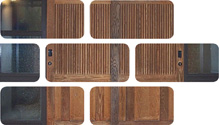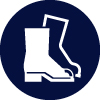
Timber Doors Wood 17 02 01
Timber doors are made in various sizes, wood types and shapes depending on the specification required. They are of varying quality, from simple hardboard internal doors to more desired pine doors, reclaimed panel doors, external hardwood doors and specialist hardwood display doors. Most doors are mass produced, whereas some are made-to-measure to suit a particular architectural finish. Some doors will incorporate glass or glazed units. Beware of fire doors clad with asbestos insulation board.
Usage & Probable Locations
Timber doors are found throughout buildings and landscaped areas. They are used for access and egress to gardens, buildings, rooms, and lofts. They are fixed with hinges into door frames that will commonly be made of timber, metal or PVCU. Timber doors may be located in all areas of a building, but will mostly be found in stud walls, panel systems and perimeter walls.
Personal Protective Equipment
PPE requirements indicated are for guidance purposes only. DRIDS has identified the PPE that is mandatory on all demolition projects and ones that may be required subject to site specific Risk Assessment & Method Statement (RAMS). Hover over the icon to determine the types of PPE required for the removal of this material.
Removal, Segregation & Storage
Depending on how timber doors have been fitted for use, will determine how they are removed, segregated and stored. Timber doors in good condition, of architectural or ornamental value and uncontaminated will have a reuse value, especially if there is a large number of similar size. They should be segregated and stored inside on timber skids or pallets and covered with plastic or tarpaulin to keep dry. They should also be stored away from plant movements to prevent breakage or splash damage. Timber doors destined for recycling or recovery should be segregated from other materials in a timber only skip. Timber doors destined for landfill can be placed in the mixed waste skip.
Tools
Fixtures, Fittings & Connections
Timber doors are commonly fixed in place with a wide range of hinges using screws, nuts and bolts, coach bolts or gudgeons and pins. Most doors will be fastened in place with a mortice lock, deadlock, door bolts, hasps and staples, latches, automatic closers or panic bolts. They may include a letterbox plate, handles, number plate and a variety of architectural or ornamental ironmongery. Most doors will be painted or preserved in one form or another. Gudgeons and pins will be built into stone or brick walls using mortar. or resin. Door frames are commonly built-into walls and fixed in place with nails, screws and mastic.
Health & Safety
Subject to task-specific Risk Assessment & Method Statement (RAMS). Use correct protective equipment for removing fixings, especially bolts, nails and screws. Wear gloves when handling timber doors with damaged edges or coated in preservatives to prevent irritation, cuts and splinters. Wear eye protection when removing nails with a crowbar, hammer or nailbar and at all times when using chisels. Use gloves and eye protection if using electric tools.










